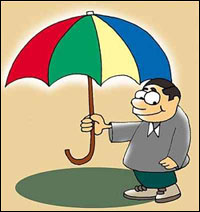 | « Back to article | Print this article |
The finance ministry's proposal to allow insurance companies to invest in AA-rated securities will broaden investment options for insurance companies but is also likely to expose their policyholders to higher risk.
 Currently, insurance companies only invest in AAA-rated securities, which restricts their choice to government bonds and debt instruments of top government-owned companies and a handful of the country's largest private sector firms. The AA-rated universe is several times bigger and various kinds of companies are its members.
Currently, insurance companies only invest in AAA-rated securities, which restricts their choice to government bonds and debt instruments of top government-owned companies and a handful of the country's largest private sector firms. The AA-rated universe is several times bigger and various kinds of companies are its members.
This diversity, however, can cause policyholders to sweat as the balance sheet of a typical AA-rated company is more leveraged and it has lower earnings cushion to service debt than AAA-rated peers.
Rating agencies and insurance companies, however, say the new norms will help insurers provide better returns to policyholders without sacrificing safety. "AA-rated securities give 50-100 basis points higher returns than AAA-rated paper and there's no great difference in risk profile," says Kartik Srinivasan, co-head, financial sector ratings at Icra. Sam Ghosh of Reliance Capital agrees.
Others point out its indirect benefit to India Inc. "It will help broaden and deepen the bond markets and from our perspective, the 'IND AA' rated universe of issuers represents a very high degree of safety,'' says Tarun Bansal, senior director and head, BRM, India Ratings & Research (formerly Fitch Ratings India).
But there are many others who advise caution. "Policyholders would definitely be subjected to some risk in case companies do migrate to AA-rated papers in a big way," says Madan Sabnavis, chief economist, CARE Ratings. His fears may not be unfounded. As the table suggests, a typical AA-rated company is four times more leveraged than AAA ones and the interest coverage ratio is much lower.
The operating profit for a typical AA-rated company is just 14 times its interest burden against 40 times for AAA-rated companies. These companies also have lower elbow room to encash their market capitalisation to retire debt in times of stress.
Not surprisingly, the proposal is deemed risky by analysts. "If you compare their balance sheets, AA-rated companies are always riskier than AAA-rated ones. The latter provide much better downside protection in bad times than the former," says Dhananjay Sinha, co-head, institutional research, Emkay Global Financial Services.
Rating agencies, however, say the risk is manageable. "There's no threat to the quality of assets if insurance companies invest in AA-rated paper judiciously and after studying the market and the company," says Sabnavis.
| THE AAA-AA COMPARISON | |||||
| AAA-rated |
AA-rated | ||||
| Average | Median | Average | Median | ||
| DER | 0.44 | 0.12 | 1.06 | 0.46 | |
| Mcap to debt* | 7.10 | 52.71 | 1.87 | 3.83 | |
| ICR | 14.34 | 39.80 | 4.99 | 7.80 | |
| CF to CP | 0.72 | 0.88 | 0.90 | 0.80 | |
| * The ratio of company market capitalisation to its gross consolidated debt as on October 1, 2012 DER: Gross debt to equity ratio; ICR: Interest coverage ratio; CF to CP: Operating cash flow to reported cash profit AAA: Total no. of companies 33, 1.5% of the entire sample of 2,100 companies (excluding banks, NBFCs and government-owned companies); AA: Total no. of companies 179 Source: Capitaline | |||||
| AA-RATED COMPANIES: A MIXED BAG | |||||
| Company | Rating | DER | Mcap to debt | ICR | CF to CP |
| SOME GOOD | |||||
| ALSTOM India | AA | 0.00 | 995.16 |
450.55 |
-0.61 |
| Eicher Motors | AA | 0.03 | 120.84 | 95.41 | 0.72 |
| Pidilite Inds. | AA+ | 0.11 | 72.62 | 17.16 | 1.32 |
| SOME NOT SO GOOD | |||||
| Adani Enterprises | AA- | 3.6 | 0.3 | 3.0 | 0.2 |
| Cox & Kings | AA | 3.1 | 0.5 | 1.6 | -1.8 |
| Tata Power Company | AA | 2.5 | 0.8 | 2.2 | 3.5 |
Experts say leaving the choice of assets to insurance companies is also fraught with danger given the number and diversity of the AA-club in India. While the AAA club has just 35 non-bank and non-government members, about 200 companies (nearly 10 per cent of the corporate universe) enjoy an AA credit rating.
That includes companies whose balance sheets and valuations are as good as those of top rated companies and also those with highly leveraged balance sheets and poor valuations (see table).
In contrast, it takes a lot of hard work and years of industry-beating performance for a company to get and retain the AAA credit rating. Not surprisingly, this privilege is currently available to only 35 non-bank and non-government companies. Many industries such as telecom, hotels, construction, textiles, retail and paper have no representation in the coveted club.